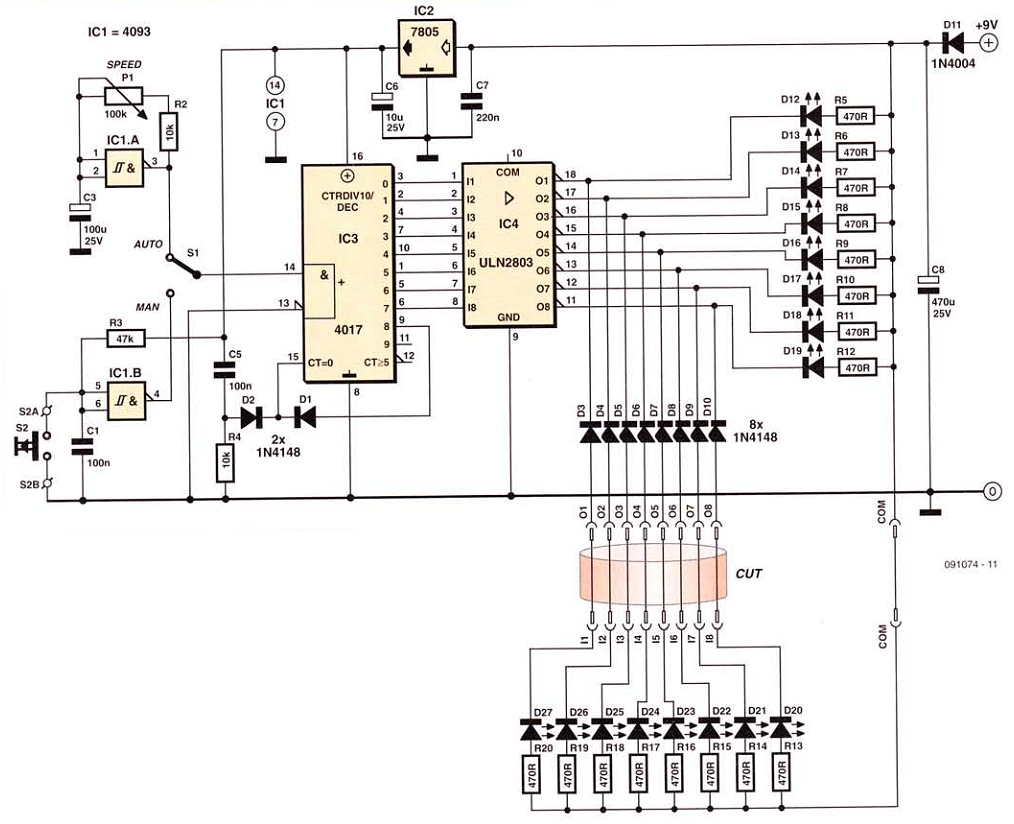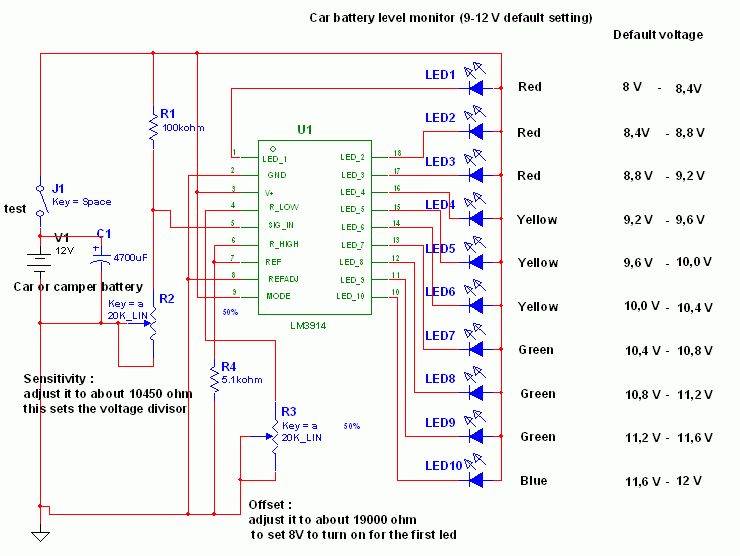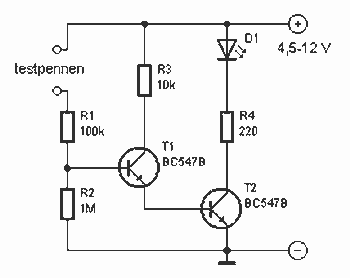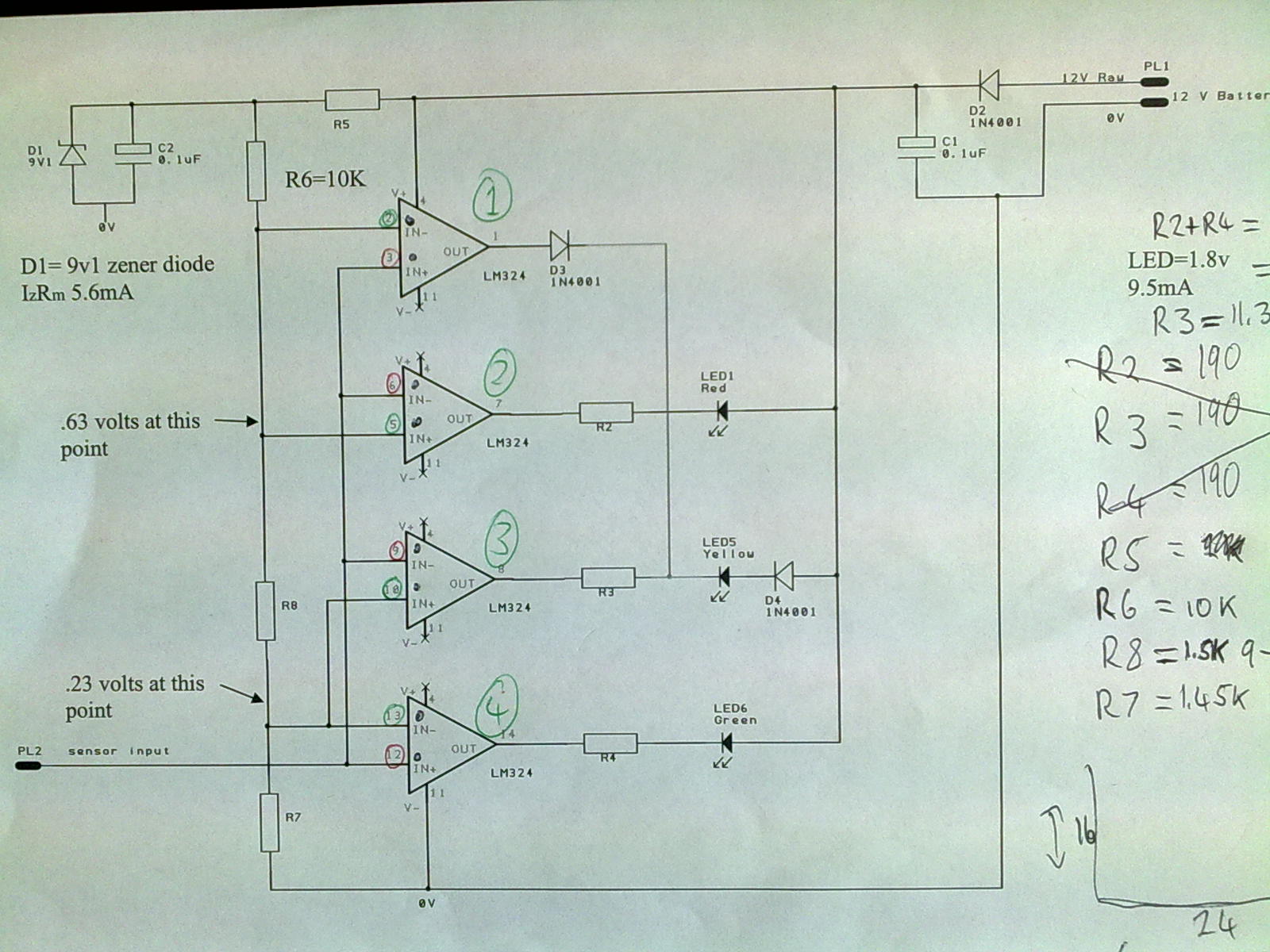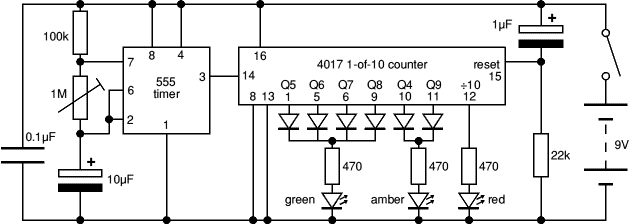
Connection Tester
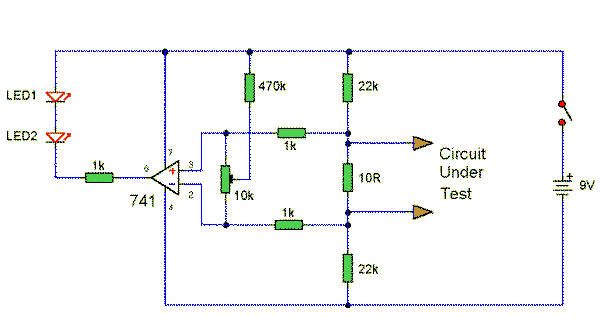
This simple circuit utilizes a 741 operational amplifier (op-amp) in differential mode to function as a continuity tester. The voltage difference between the non-inverting and inverting inputs is amplified by the op-amp's full open-loop gain. Initially, if the resistors were perfectly matched, the voltage difference would be zero, resulting in an output of zero. However, the inclusion of a 470kΩ resistor and a 10kΩ control allows a small potential difference to be applied across the op-amp inputs, disrupting the circuit's balance. This imbalance is amplified, causing the op-amp output to swing to the full supply voltage, which in turn illuminates the LEDs. The probes should first be connected to a resistor with a value between 0.22Ω and 4Ω. The control is adjusted until the LEDs just light up with the resistance across the probes. After this, the resistor should be removed, and the probes should be short-circuited, resulting in the LEDs extinguishing. Given the extremely low resistance value, it is crucial to keep the probes (whether crocodile clips or needles) clean, as dirt can increase contact resistance and lead to circuit malfunction. The circuit is also compatible with MOSFET-type op-amps such as the CA3130, CA3140, and JFET types like the LF351. If the LEDs do not turn off, a 10kΩ preset should be connected across the offset null terminals (pins 1 and 5), with the wiper of the control linked to the negative battery terminal. A pinout for the 741 op-amp is also available.
This circuit design operates effectively as a continuity tester, leveraging the differential amplification capabilities of the 741 op-amp. The circuit configuration consists of the op-amp, two input probes, a 470kΩ resistor, a 10kΩ variable resistor, and a pair of LEDs for visual indication. The continuity tester is designed to detect low resistances, typically in the range of 0.22Ω to 4Ω.
Upon connecting the probes to the resistor, the 10kΩ control is adjusted to achieve a threshold where the LEDs just illuminate. This adjustment is critical for calibrating the circuit to ensure sensitivity to low resistance values. Once calibrated, removing the resistor and shorting the probes should result in the LEDs turning off, indicating successful operation.
To enhance performance and reliability, it is important to maintain clean contact surfaces on the probes, as contamination can introduce unwanted resistance, affecting the circuit's accuracy. The versatility of the circuit is notable, as it can accommodate various op-amp types, including MOSFET and JFET configurations, broadening its applicability in different electronic testing scenarios.
In instances where the LEDs remain illuminated after shorting the probes, a 10kΩ preset resistor can be employed across the offset null terminals of the op-amp to fine-tune the output and restore normal operation. This adjustment allows for compensation of any inherent offset voltage, ensuring the circuit functions correctly across a range of conditions.
Overall, this continuity tester circuit represents a practical and efficient solution for measuring low resistances in electronic applications, with straightforward calibration and maintenance requirements.This simple circuit uses a 741 op-amp in differential mode as a continuity tester. The voltage difference between the non-inverting and inverting inputs is amplified by the full open loop gain of the op-amp. Ignore the 470k and the 10k control for the moment, and look at the input of the op-amp. If the resistors were perfectly matched, then the vo ltage difference would be zero and output zero. However the use of the 470k and 10k control allows a small potential difference to be applied across the op-amp inputs and upset the balance of the circuit. This is amplified causing the op-amp output to swing to full supply voltage and light the LED`s. The probes should first be connected to a resistor of value between 0. 22 ohm and 4ohm. The control is adjusted until the LED`s just light with the resistance across the probes. The resistor should then be removed and probes short circuited, the LED`s should go out. As the low resistance value is extremely low, it is important that the probes, (whether crocodile clips or needles etc) be kept clean, otherwise dirt can increase contact resistance and cause the circuit to mis-operate.
The circuit should also work with a MOSFET type op-amp such as CA3130, CA3140, and JFET types, e. g. LF351. If the lED`s will not extinguish then a 10k preset should be wired across the offset null terminals, pins 1 and 5, the wiper of the control being connected to the negative battery terminal. A pin out for the 741 can also be found here 🔗 External reference
This circuit design operates effectively as a continuity tester, leveraging the differential amplification capabilities of the 741 op-amp. The circuit configuration consists of the op-amp, two input probes, a 470kΩ resistor, a 10kΩ variable resistor, and a pair of LEDs for visual indication. The continuity tester is designed to detect low resistances, typically in the range of 0.22Ω to 4Ω.
Upon connecting the probes to the resistor, the 10kΩ control is adjusted to achieve a threshold where the LEDs just illuminate. This adjustment is critical for calibrating the circuit to ensure sensitivity to low resistance values. Once calibrated, removing the resistor and shorting the probes should result in the LEDs turning off, indicating successful operation.
To enhance performance and reliability, it is important to maintain clean contact surfaces on the probes, as contamination can introduce unwanted resistance, affecting the circuit's accuracy. The versatility of the circuit is notable, as it can accommodate various op-amp types, including MOSFET and JFET configurations, broadening its applicability in different electronic testing scenarios.
In instances where the LEDs remain illuminated after shorting the probes, a 10kΩ preset resistor can be employed across the offset null terminals of the op-amp to fine-tune the output and restore normal operation. This adjustment allows for compensation of any inherent offset voltage, ensuring the circuit functions correctly across a range of conditions.
Overall, this continuity tester circuit represents a practical and efficient solution for measuring low resistances in electronic applications, with straightforward calibration and maintenance requirements.This simple circuit uses a 741 op-amp in differential mode as a continuity tester. The voltage difference between the non-inverting and inverting inputs is amplified by the full open loop gain of the op-amp. Ignore the 470k and the 10k control for the moment, and look at the input of the op-amp. If the resistors were perfectly matched, then the vo ltage difference would be zero and output zero. However the use of the 470k and 10k control allows a small potential difference to be applied across the op-amp inputs and upset the balance of the circuit. This is amplified causing the op-amp output to swing to full supply voltage and light the LED`s. The probes should first be connected to a resistor of value between 0. 22 ohm and 4ohm. The control is adjusted until the LED`s just light with the resistance across the probes. The resistor should then be removed and probes short circuited, the LED`s should go out. As the low resistance value is extremely low, it is important that the probes, (whether crocodile clips or needles etc) be kept clean, otherwise dirt can increase contact resistance and cause the circuit to mis-operate.
The circuit should also work with a MOSFET type op-amp such as CA3130, CA3140, and JFET types, e. g. LF351. If the lED`s will not extinguish then a 10k preset should be wired across the offset null terminals, pins 1 and 5, the wiper of the control being connected to the negative battery terminal. A pin out for the 741 can also be found here 🔗 External reference
